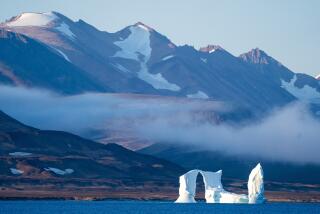Climate change breaks the ice: 3-man sailboat makes record voyage
Warming global temperatures and melting polar ice caps have helped a trio of explorers go where few men have gone before.
In an account of their voyage posted Monday, the crew of the 31-foot Belzebub II — a fiberglass sailboat with a living space the size of a bathroom — described how they crossed through the M’Clure Strait in northern Canada, a decreasingly ice-packed route through the famed Northwest Passage.
The international three-man crew — an American, Canadian and Swede — claim to have piloted the first sailboat to do so.
The route is named after 19th century British explorer Robert McClure, the first person to cross the elusive Arctic passage that connects the Atlantic Ocean to the Pacific, an arduous, frosty trek that nearly killed his men.
But last week, scientists said the area of floating sea ice in the Arctic had fallen to the lowest level ever observed. As the Belzebub II lingered in the Prince of Wales Strait, its crew — which includes Morgan Peissel, a Boston native and an assistant to filmmaker Errol Morris — received the message from Canadian ice-watching officials that set them in motion: “Good afternoon. It’s not recommended to go into M’Clure Strait, but there is a window open north of Banks. There is a lead developing all along the North shore of Banks Island.”
The ice would return soon, but the decision to go was made “in a heartbeat,” the crew said Monday in a blog post. The Belzebub II then swam into the dangerous strait as walls of ice surrounded the small sailboat, the crew uncertain of whether the ship could make the passage.
The sailors eyed ice measurements and worried about hitting features underwater. At one point, they spotted the motorboat of another explorer, but it didn’t respond to a radio hailing before vanishing into the fog.
Twenty-four hours into the attempt, going without any sleep, the explorers said they got word that walls of ice were closing the passageway behind them. They hurried ahead, and their craft knifed through clear waters for another 12 hours and finally brought them to their destination just beyond the strait on Wednesday.
“With sails up in a light breeze we sailed swiftly toward the Northwest point of Banks Island and to becoming the first sailboat in history to complete this route,” the crew wrote in their post. A Canadian reconnaissance plane hailed them and congratulated them, looping around the boat.
“We exchanged salutations and their ice cameras captured us accomplishing what we had worked towards for almost two years,” the crew wrote. The sailboat then continued its westward journey, toward Alaskan waters and the Bering Sea.
The crew, which also includes Edvin Buregren, a Swede, and Nicolas Peissel, a Canadian, set out on the quest to bring awareness to the changing climate that has radically reshaped the planet’s North Pole.
“Our approach to sail across a historical stretch of water that has traditionally been frozen is meant to be a clear visual example of the extent of declining polar ice,” the group said in a statement.
Though environmentalists decry the shrinking polar ice caps — and coastal regions are already having to cope with the ominous (and expensive) rise of sea levels — the opening of the traditionally ice-blocked Northwest Passage would bring potentially lucrative new shipping routes.
NASA officials say the passage known as the Perry Channel, which connects Baffin Bay to M’Clure Strait, would be the route through the Arctic “most conducive” to large-scale shipping.
The Belzebub II, in the meantime, is expected to continue its journey toward the Pacific Ocean to become the first sailboat to navigate the Northwest Passage, the sailors said.
ALSO:
Boy, 6, slashed in another child killing in Camden, N.J.
Movie massacre: Did James Holmes call hospital before shooting?
Arizona Sheriff Joe Arpaio vows to continue enforcing illegal immigration laws
More to Read
Sign up for Essential California
The most important California stories and recommendations in your inbox every morning.
You may occasionally receive promotional content from the Los Angeles Times.










